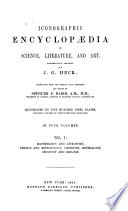 | T. Baker - 1851 - 172 pages
...weight of a column of the fluid, the base of which is the surface pressed, and the height equal to the depth of its centre of gravity below the surface of the fluid. Let the whole surface S be divided into an indefinite number of parts s, s', &c., the distances of... | |
 | 1851 - 716 pages
...liquid, whose horizontal base is equal to the area of the portion in question, and whose altitude is the depth of its centre of gravity below the surface of the liquid. Fig. 5 illustrates the pressure upon the different points of the vertical side of a vessel.... | |
 | Johann Georg Heck - 1851 - 712 pages
...liquid, whose horizontal base is equal to the area of the portion in question, and whose altitude is the depth of its centre of gravity below the surface of the liquid. Fig. 5 illustrates the pressure upon the different points of the vertical side of a vessel.... | |
 | Jeremiah Joyce - 1852 - 606 pages
...perpendicular, horizontal, or oblique, the pressure of a body of water is always equal to the product of the surface multiplied by the depth of its centre of gravity. Ch. Will you be kind enough to explain this, Papa? Fa. Suppose you wish to find the pressure upon the... | |
 | Augustus William Smith - 1855 - 368 pages
...ment of inertia of the surface, and that the denominator is the statical moment. Hence the denominator is equal to the area of the surface multiplied by the depth of its center of gravity (29). Hence, if A be the area and ie, this depth, <148> 396. PROP. To find the center... | |
 | Augustus William Smith - 1855 - 340 pages
...ment of inertia of the surface, and that the denominator is the statical moment. Hence the denominator is equal to the area of the surface multiplied by the depth of its center of gravity (29). Hence, if A be the area and x^ this depth, <148> CENTER OF PRESSURE. A B surface... | |
 | Johann Georg Heck - 1860 - 332 pages
...liquid, whose horizontal base is equal to the area of the portion in question, and whose altitude is the depth of its centre of gravity below the surface of the liquid. Fig. 5 illustrates the pressure upon the different points of the vertical side of a vessel.... | |
 | G. R. Smalley - 1862 - 190 pages
...column of the fluid, having its base and height respectively equal to the area of the surface, and the depth of its centre of gravity below the surface of the fluid. 8. Resultant Horizontal Pressure. — The horizontal pressures upon the surface of a vessel containing... | |
 | Augustus William Smith - 1863 - 340 pages
...ment of inertia of the surface, and that the denominator is the statical moment. Hence the denominator is equal to the area of the surface multiplied by the depth of its center of gravity (29). Hence, if A be the area and x, this depth, ' CENTER OF PRESSURE. surface vertically... | |
 | Samuel Maunder - 1866 - 884 pages
...equal In every direction. The pressure of a fluid on any surface Is equal to the surface mul 1 1 piled by the depth of Its centre of gravity below the surface of the fluid. Fluldeare divided luto elastic and non-elastic : these are, however, relative terms, all fluids being... | |
| |